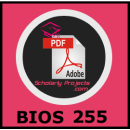BIOS 255 Anatomy & Physiology III with Lab

This Chamberlain course is the third in a four-course sequence in which human anatomy and physiology are studied using a body systems approach. Coursework emphasizes interrelationships between form and function at the gross and microscopic levels of organization. Topics include the cardiovascular, immune and respiratory systems. The course describes the human body systems, explaining in general terms what the system does and how it interacts with other systems. These systems include the heart, blood and lymphatic and respiratory systems.
Understanding anatomical and physiological concepts as they apply in the healthcare delivery setting as opposed to the scientific investigational realm is stressed. Emphasis is placed on physiological parameters and meanings as opposed to simply anatomical descriptions.
Laboratory exercises will complement the course material to combine, integrate and relate the basic facts and concepts acquired in the lectures. These activities are designed to promote critical thinking and application skills. Wherever possible, we will emphasize the use of life experiences, plausible clinical situations and common diagnostic problems, thus drawing upon the students' analytical and organizational powers.
BIOS 255 All Quizzes, Midterm & Final Exams
Week 2 & Week 5 Quizzes, Week 4 Midterm & Final Exams: (Potential Essays; MCQs & Explanatory) - Bundled BIOS 255 Week 2 | Quiz -- $25.00BIOS 255 Week 5 | Quiz -- $15.00BIOS 255 Week 4 | Midterm Exam -- $35.00BIOS 255 Week 8 | Final Exam (MCQs & Explanatory) -- $35.00BIOS 255 Week 8 | Final Exam (Potential Essays) -- $15.00Note: This Bundle is cheaper than the individual Quizzes & Exams...
$65.00
BIOS 255 Week 2 | Quiz
Questions: 1-291. Which blood vessels permit exchange between the blood and surrounding interstitial fluid?2. The venae cavae and their tributaries in the abdominopelvic cavities are examples of3. Which vessel wall layer forms a sheath of connective tissue and has collagen fibers that may intertwine with those of adjacent tissues?4. Which layer is thicker in a medium-sized artery versus a medium-sized vein?5. Which vessels have valves t..
$10.00
BIOS 255 Week 4 | Midterm Exam
Questions: 1-381. (TCO3) Which of the following is a major function of blood?2. (TCO3) Which of the following blood types is a person whose blood cells were not agglutinated by anti-A serum, anti-B serum, and anti-Rh serum3. (TCO3) Which of the following formed elements in blood are removed by fixed macrophages in the spleen and liver after about 4 months in the circulation?4. (TCO3) A condition in which inadequate intake of vitamin B12 or fo..
$20.00
BIOS 255 Week 5 | Quiz
Questions: 1-101. (TCO4) What is the major difference between lymph and interstitial fluid? (Points : 2) 2. (TCO4) Lack of resistance is also known as (Points : 2) 3. (TCO4) Which of the following is an INCORRECT matching of immune system cells and their function? (Points : 2) 4. (TCO4) Which type of allergic reaction is mediated by T cells? (Points : 2) 5. (TCO4) Which of the following is NOT an effect of aging on the immune system? (P..
$10.00
BIOS 255 Week 8 | Final Exam (MCQs & Explanatory)
Questions: 1-361. Which method of acquiring adaptive immunity results from mother-to-baby immunoglobulin transfer via breast feeding?2. Which of the following is NOT a function of the lymphatic and immune system?3. Exhalation begins when4. Which of the following precursor cells eventually give rise to platelets?5. The membrane that surrounds and protects the heart is called the:6. What area in the figure below is the vital c..
$20.00
BIOS 255 Week 8 | Final Exam (Potential Essays)
Questions: 1-101. Describe innate and adaptive immune systems, how they work and how they interact.2. Explain the various subclasses of antibodies – how they are similar, how they differ.3. Define ventilation, external respiration and internal respiration. Be sure to identify their functions and were they occur.4. Explain the neural control of ventilation including brain centers, sensory and motor signals.5. Describe how oxygen and carb..
$15.00


